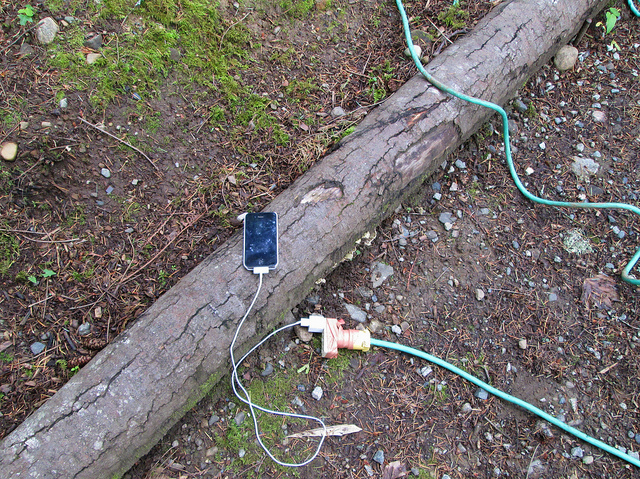Like this article? rabble is reader-supported journalism. Chip in to keep stories like these coming.
Summer is a time when many of us head to mountains, woodlands and seasides hoping to unwind and recharge. But when we head out on vacation with our smartphones, tablets, cameras and radios we find recharging them daily more challenging than keeping deer flies at bay.
So, here’s my advice about how to cope.
First, be judicious about what you take. I’m not saying that from a sanctimonious: “why can’t you just unplug for two weeks?” soapbox. We live in a time when the GPS and cameras in our phones, the book-reading apps in our tablets and our movies on our tablets add to our safety, our rainy day downtime and our ability to capture memories. But that doesn’t mean everything has to come along for the ride.
A book reader like a Kindle, for example, is a far better choice than a small tablet because the e-ink screen and backlighting can last for two weeks without recharging. And, you can probably get along with the Kindle and a smartphone combo, especially if the smartphone has a large screen.
Second, kick your devices into low-power mode if you can. You can do this a couple of ways. It’s likely the case that in the woods you won’t need WiFi, so turn that off. Same with Bluetooth, unless you have to connect to a wireless keyboard or other peripheral. Killing both those radios will save your juice and you’ll still be able to make voice and data calls, provided you’re within the coverage area of your provider.
If you don’t need to make calls, put the device in airplane mode until you need to use the phone that way. And, the current operating systems on iOS and Android-powered smartphones now let you drop into low-power or battery-saver mode either when the battery is drained to a certain level or when you manually turn it on. Turn it on. Yes, your smartphone or tablet will run a bit slower and background apps will take longer to refresh, but you’ll gain hours of use from a single charge.
Even if you’re using your device for taking pictures, consider dimming the screen. If you run your screen bright all the time you’ll quickly drain the battery. Shade the screen to frame your shots.
But, if you’re away for a long trip, those techniques will only get you partway through the first week. To keep the devices going past that you’ll need some kind of external battery pack or charger. Here’s what I suggest. Get yourself a small external rechargeable battery for each device you need to keep alive. You can also get larger battery packs that can charge smartphones and even small tablets multiple times. Just make sure you top it up before you leave. And, get a solar charging panel capable of charging one of your smaller packs in less than a day in bright sunlight. Some panels are rigid and are best left on the ground (tilted and facing south) back at camp. Others are flexible or small enough that they can go on the outside of a backpack. On a camping trip last week I ran into two cycle tourists who were travelling across Canada. One had her smartphone attached to her handlebars and powered it will a foldable Anker solar charger draped over her front bag.
On my trip I took a Yolk solar paper charger that worked wonderfully. Other companies like Goal Zero, Anker and Solio make solid, waterproof devices as well. Some have chargers built in; others, like the Yolk, need to have an external pack attached. This is the setup I prefer because the solar chargers tend to be cheaper and you probably already have a rechargeable pack or two.
But, let’s say it rains the first week of your trip, so the solar chargers are useless and you’ve burned through your packs. Now what? I haven’t been above sneaking into empty electrical campsites and sipping from an outlet there. Or, if you’re near a town, you can charge in a coffee shop or laundromat. Hopefully though, that kind of scofflaw behaviour won’t be necessary if the weather co-operates and you husband your juice wisely. And, really, husbanding your juice is just a good idea anytime.
Listen to an audio version of this column, read by the author.
Wayne MacPhail has been a print and online journalist for 25 years, and is a long-time writer for rabble.ca on technology and the Internet.
Photo: Heather Harvey/flickr
Like this article? rabble is reader-supported journalism. Chip in to keep stories like these coming.




